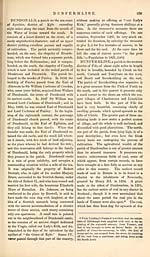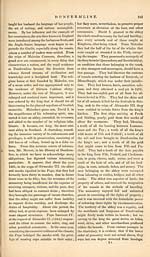Gazetteer of Scotland > Volume 1
(272) Page 240 - DUN
Download files
Complete book:
Individual page:
Thumbnail gallery: Grid view | List view

240
DUNFERMLINE.
hundred years, is yet far from being exhausted.
The Earl of Elgin is one of the chief pro-
prietors, and his collieries are upon a very large
scale ; he possesses coal fields to the amount
of nine hundred square acres, which consist of
a variety of seams, measuring from six inches
to six feet in thickness. The next colliery
in point of extent in the parish is that of
Halbeath. It contains eight or nine seams of
good workable coal ; the lowest or splint
seam is in high repute. From this colliery
vast quantities of coal have been long export-
ed. There is a rail-road from the works
to the port of Inverkeithing, at which the
coal is shipped. In connexion with this col-
liery, there is a pretty extensive salt-work
carried on at the same port. Baldridge col-
liery is also very extensive. It is situated
within half a mile of Dunfermline, where the
produce is much used. A new pit was lately
sunk here, and a powerful steam-engine erected,
to arrive at the splint seam, which is of great
value and in much esteem. About a mile
distant from the town is situated the Town-
hill colliery, which is wrought only on a
small scale, and where the burgesses are en-
titled to be supplied at a cheaper rate than
others. The coal strata extend nearly from
east to west, and consist of a variety of seams,
the principal of which are four and five
feet thick. The strata dip generally to the
north and north-east, at a declivity of about
one foot in six, to ten feet. All the collieries
in this district are free from the noxious gases,
so that scarcely any accident takes place aris-
ing from this source. It is calculated that the
quantity of coal annually raised in the parish,
rr ay amount to one hundred and thirty thou-
sand tons. Ironstone is likewise found in
great abundance. In Lord Elgin's collieries
alone there are raised above four thousand tons.
The stone is interspersed throughout all the
coal fields. Limestone, another usual at-
tendant on coal, is also quarried and burnt to a
considerable extent. Much of this article is
shipped at Charlestown. Of freestone, of a
very excellent pure quality, there is likewise
an inexhaustible store in all parts of the dis-
trict. There is also plenty of whinstone ;
but it is little used in house-building. Besides
Charlestown and Limekilns, the parish pos-
sesses the villages of Crossford, Crossgates,
Patie-moor, Mastertown, and Halbeath, which
lire noticed in their several places.
Dunfermline, a royal burgh, the capi-
tal of the above parish, and the chief town
in the western part of Fife, occupies m agree-
able, though not very commodious situation, on I
an extensive eminence, stretching from east to
west, having a pretty steep and uniform decli-
vity to the south, and about 270 feet above the
level of the sea. It stands at the distance of
three miles from Limekilns, the nearest part of
the coast ; six from the North Queensferry ;
thirteen from Kirkaldy ; thirty from Cupar, the
county town ; and sixteen from Edinburgh.
From its elevated situation, the prospects all
around are very extensive, and the objects much
varied. The pleasure-grounds of Pitten-
crieff, of Cavill, of Pitfirran, and of Pitliver,
are almost immediately below the eye ; those
of Broomhall, a little farther to the south.
The Forth is seen in extensive openings from
near Stirling to Leith. The word Dunferm-
line, (ordinarily pronounced Dumferline,) sig-
nifies in Gaelic, the fort by the crooked rivu-
let. The fort here alluded to, was one
erected by Malcolm Canmore on a peninsular
mount in PittencriefF glen, and such a circum-
stance places the origin of the town in the
remote epoch of the eleventh century. The
hamlet which sprung up in the vicinity of the
castle of Malcolm was hastened in its progress
by the establishment of a religious house close
beside it. While the hamlet of Dunfermline
was thus in a primitive condition, it received
a prodigious increase in its importance by an
event very intimately connected with the des-
tinies of Scotland, namely, the marriage of
Malcolm with Margaret, the sister of Edgar
Ethcling. This unfortunate Anglo-Saxon
prince having been dethroned, and his king-
dom seized, by William the Conqueror, he
fled from England with his family, and on his
voyage to the continental territories of his
forefathers, was driven by a storm on the
coast of Fife, near the residence of Mal-
colm Canmore, a sovereign who had some
time before endeavoured to mitigate his
misfortunes. The result is well known :
Margaret became his queen, and proved ail
inestimable blessing, not only to her royal
spouse, but to the whole nation over which her
husband ruled. In consequence of her settle-
ment in Scotland, the country became the
place of refuge to a great number of Anglo-
. Saxon exiles and emigrants, with their follow-
ers of various denominations. The queen
DUNFERMLINE.
hundred years, is yet far from being exhausted.
The Earl of Elgin is one of the chief pro-
prietors, and his collieries are upon a very large
scale ; he possesses coal fields to the amount
of nine hundred square acres, which consist of
a variety of seams, measuring from six inches
to six feet in thickness. The next colliery
in point of extent in the parish is that of
Halbeath. It contains eight or nine seams of
good workable coal ; the lowest or splint
seam is in high repute. From this colliery
vast quantities of coal have been long export-
ed. There is a rail-road from the works
to the port of Inverkeithing, at which the
coal is shipped. In connexion with this col-
liery, there is a pretty extensive salt-work
carried on at the same port. Baldridge col-
liery is also very extensive. It is situated
within half a mile of Dunfermline, where the
produce is much used. A new pit was lately
sunk here, and a powerful steam-engine erected,
to arrive at the splint seam, which is of great
value and in much esteem. About a mile
distant from the town is situated the Town-
hill colliery, which is wrought only on a
small scale, and where the burgesses are en-
titled to be supplied at a cheaper rate than
others. The coal strata extend nearly from
east to west, and consist of a variety of seams,
the principal of which are four and five
feet thick. The strata dip generally to the
north and north-east, at a declivity of about
one foot in six, to ten feet. All the collieries
in this district are free from the noxious gases,
so that scarcely any accident takes place aris-
ing from this source. It is calculated that the
quantity of coal annually raised in the parish,
rr ay amount to one hundred and thirty thou-
sand tons. Ironstone is likewise found in
great abundance. In Lord Elgin's collieries
alone there are raised above four thousand tons.
The stone is interspersed throughout all the
coal fields. Limestone, another usual at-
tendant on coal, is also quarried and burnt to a
considerable extent. Much of this article is
shipped at Charlestown. Of freestone, of a
very excellent pure quality, there is likewise
an inexhaustible store in all parts of the dis-
trict. There is also plenty of whinstone ;
but it is little used in house-building. Besides
Charlestown and Limekilns, the parish pos-
sesses the villages of Crossford, Crossgates,
Patie-moor, Mastertown, and Halbeath, which
lire noticed in their several places.
Dunfermline, a royal burgh, the capi-
tal of the above parish, and the chief town
in the western part of Fife, occupies m agree-
able, though not very commodious situation, on I
an extensive eminence, stretching from east to
west, having a pretty steep and uniform decli-
vity to the south, and about 270 feet above the
level of the sea. It stands at the distance of
three miles from Limekilns, the nearest part of
the coast ; six from the North Queensferry ;
thirteen from Kirkaldy ; thirty from Cupar, the
county town ; and sixteen from Edinburgh.
From its elevated situation, the prospects all
around are very extensive, and the objects much
varied. The pleasure-grounds of Pitten-
crieff, of Cavill, of Pitfirran, and of Pitliver,
are almost immediately below the eye ; those
of Broomhall, a little farther to the south.
The Forth is seen in extensive openings from
near Stirling to Leith. The word Dunferm-
line, (ordinarily pronounced Dumferline,) sig-
nifies in Gaelic, the fort by the crooked rivu-
let. The fort here alluded to, was one
erected by Malcolm Canmore on a peninsular
mount in PittencriefF glen, and such a circum-
stance places the origin of the town in the
remote epoch of the eleventh century. The
hamlet which sprung up in the vicinity of the
castle of Malcolm was hastened in its progress
by the establishment of a religious house close
beside it. While the hamlet of Dunfermline
was thus in a primitive condition, it received
a prodigious increase in its importance by an
event very intimately connected with the des-
tinies of Scotland, namely, the marriage of
Malcolm with Margaret, the sister of Edgar
Ethcling. This unfortunate Anglo-Saxon
prince having been dethroned, and his king-
dom seized, by William the Conqueror, he
fled from England with his family, and on his
voyage to the continental territories of his
forefathers, was driven by a storm on the
coast of Fife, near the residence of Mal-
colm Canmore, a sovereign who had some
time before endeavoured to mitigate his
misfortunes. The result is well known :
Margaret became his queen, and proved ail
inestimable blessing, not only to her royal
spouse, but to the whole nation over which her
husband ruled. In consequence of her settle-
ment in Scotland, the country became the
place of refuge to a great number of Anglo-
. Saxon exiles and emigrants, with their follow-
ers of various denominations. The queen
Set display mode to: Large image | Transcription
Images and transcriptions on this page, including medium image downloads, may be used under the Creative Commons Attribution 4.0 International Licence unless otherwise stated. ![]()
| Gazetteers of Scotland, 1803-1901 > Gazetteer of Scotland > Volume 1 > (272) Page 240 - DUN |
|---|
| Permanent URL | https://digital.nls.uk/97427626 |
|---|
| Description | Volume I: Abbey to Glenartney. |
|---|---|
| Attribution and copyright: |
|
| Description | By Robert Chambers and William Chambers. Glasgow: Blackie & Son, 1838. 2 volumes. |
|---|---|
| Shelfmark | NF.1461.g.7 |
| Additional NLS resources: | |

